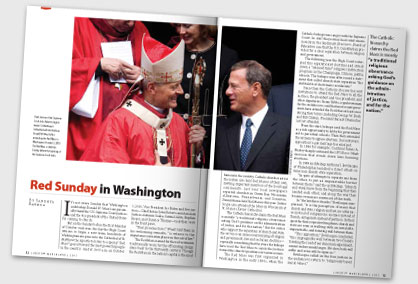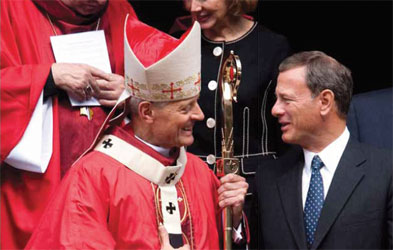Red Sunday in Washington
Sandhya Bathija March/April 2011
It's not every Sunday that Washington archbishop Donald W. Wuerl can personally thank the U.S. Supreme Court justices and the vice president of the United States for coming to church.
But on the Sunday before the first Monday of October each year, the day the High Court returns to begin a new term, hundreds of Washingtonians pour into the Cathedral of St. Matthew the Apostle to listen to a special "Red Mass" geared toward the most powerful people in the country. And at 10:00 a.m. on October 3, 2010, Vice President Joe Biden and five justices—Chief Justice John Roberts and Associate Justices Antonin Scalia, Samuel Alito, Stephen Breyer, and Clarence Thomas—took their seats in the front pews.
"Your presence here," Wuerl told them in his welcoming remarks, "is witness to the importance our nation places on the rule of law."
The Red Mass, named for the red vestments traditionally worn by the officiating clergy, dates back to the thirteenth century. Though the Red Mass in the nation's capital is the most famous in the country, Catholic churches across the nation also hold Red Masses of their own, inviting important members of the local legal community. Last year local newspapers reported churches in Green Bay, Wisconsin; Allentown, Pennsylvania; and Scranton, Pennsylvania held Red Masses this year. Justice Scalia also attended the Mass in Wisconsin at St. Francis Xavier Cathedral.
The Catholic hierarchy claims the Red Mass is merely "a traditional religious observance asking God's guidance on the administration of justice, and for the nation." But for critics who support the separation of church and state, the service is an unnecessary mixing of religion and government, law and sectarian doctrine—especially considering that for years the bishops have used the Red Mass to cajole the justices toward the church's positions on various issues.
The Red Mass was first organized in Washington in the early 1950s, when the Catholic bishops were angry with the Supreme Court. In 1947 the justices had ruled unanimously in the landmark Everson v. Board of Education case that the U.S. Constitution provided for a clear separation between religion and government.
The following year the High Court reiterated this separationist doctrine and struck down a "released time" religious instruction program in the Champaign, Illinois, public schools. The bishops soon after issued a statement that called church-state separation "the shibboleth of doctrinaire secularism."
Since then the Catholic diocese has sent invitations to attend the Red Mass to all the justices, the president and vice president, and other dignitaries. Susan Gibbs, a spokeswoman for the archdiocese, said that most recent presidents have attended the Red Mass at least once during their terms, including George W. Bush and Bill Clinton. President Barack Obama has not yet attended.
From the start, bishops used the Red Mass as a rich opportunity to lobby for government aid to parochial schools. Then they extended the sermons to oppose abortion. In recent years, opposition to gay marriage has emerged.
In 1986 for example, Cardinal James A. Hickey sharply criticized the 1973 Roe v. Wade decision that struck down laws banning abortions.
In 1989 Archbishop Anthony J. Bevilacqua of Philadelphia launched a direct attack on American church-state separation.
"In spite of attempts to separate one from the other, to put an impenetrable barrier between them," said the archbishop, "[church and state] knew from the beginning that they needed each other, and along the way they became even more convinced of this truth.
In "the last three decades," Bevilacqua complained, "it is the perception of many that church and state, religion and law, are adversaries instead of companions, enemies instead of friends, antagonists instead of partners. In their quest for their respective kingdoms, church and state are seen as walking with an inviolable, impenetrable, and towering wall between them.
"This opposition," Bevilacqua concluded, "this impregnable wall between two friends traveling the road of our American experiment, cannot endure much longer. If it does, both will suffer and crisis will be upon us."
Bevilacqua called on the four justices in the audience to return to "religiously based moral values."
But the bishops' tactics have sometimes alienated members of the High Court.
A new biography of the late Justice William Brennan recounts a Red Mass following the two major school-prayer decisions of the 1960s—Engel v. Vitale and Abington School District v. Schempp. Brennan, a Catholic, wrote a concurring opinion in Schempp to explain why the Court struck down the reading of Bible passages at the start of each public school day.
In Justice Brennan: Liberal Champion authors Seth Stern and Stephen Wermiel say Brennan's hope was to ease the church's anger over the issue. But at the Red Mass in Washington he and the other justices were publicly scolded by the Bishop John J. Russell.
"Thank God, our Constitution forbids the state's setting up or favoring any particular form of religion," Russell said. "But that separation of church and state, which we all cherish in our country, never meant the divorce of government from religion or the separation of law from morality."
Brennan's wife, Marjorie, who was also in attendance, was deeply offended by the bishop's public chastisement. As she kissed the bishop's ring, she blurted out, "You're not fit for my husband or me to kiss your ring!"
Brennan is not the only justice who has been deeply offended by the church's rhetoric over sensitive issues. Justice Ruth Bader Ginsburg was also appalled after attending the Red Mass and discontinued her attendance at the event.
In an interview with Abigail Pogrebin, author of Stars of David: Prominent Jews Talk About Being Jewish, Ginsburg said: "I went one year and I will never go again, because this sermon was outrageously anti-abortion. Even the Scalias—although they're very much of that persuasion—were embarrassed for me."
In recent years, possibly because of Ginsburg's reaction and negative media attention, the Red Mass sermons have become much less direct, with clergy using guarded language to cloak the underlying message.
Archbishop J. Augustine Di Noia followed that approach in his 2010 homily in Washington.
"Positive law," he said, "rests on certain principles the knowledge of which constitutes nothing less than a participation in the divine law itself: the pursuit of the common good through respect for the natural law, the dignity of the human person, the inviolability of innocent life from conception to natural death, the sanctity of marriage, justice for the poor, protection of minors, and so on."
 Chief Justice of the Supreme Court John Roberts (right) leaves St.
Matthew's Cathedral with Archbishop Donald W. Wuerl after attending the
Red Mass in Washington, October 3, 2010. The Red Mass is held the Sunday
before the opening of the Supreme Court Term.
Chief Justice of the Supreme Court John Roberts (right) leaves St.
Matthew's Cathedral with Archbishop Donald W. Wuerl after attending the
Red Mass in Washington, October 3, 2010. The Red Mass is held the Sunday
before the opening of the Supreme Court Term.
Di Noia, an American who now works at the Vatican, argued that "the democratic state does not so much confer the most fundamental human rights and the duties of citizenship as acknowledge their existence and source in a power beyond the state, namely in God himself."
The archbishop criticized any move toward what he called "exclusive humanism" as a basis for government.
"This exclusive humanism," he said, "has been exposed as an anti-humanism of the most radical kind. Man without God is not more free but surely in greater danger." He added that "the eclipse of God leads not to greater human liberation but to the most dire human peril. That innocent human life is now so broadly under threat has seemed to many of us one of the many signs of this growing peril."
References to the "sanctity of marriage" and "innocent human life" are likely references to the church's stand against civil marriage for same-sex couples and against legal abortion.
Church officials today claim they do not try to persuade anyone in attendance at the Red Mass. Wuerl told CNN that that event is just an opportunity to put aside partisanship and troubles.
"[Americans have] been very careful about . . . not allowing any one tradition or church to become the state church," he said. "But from the very beginning, we've always said we need to hear the voice of faith in all the discussion that is a part of determining what we want to do."
Despite the church hierarchy's claims, the Red Mass has always been a church-state concern. When it comes to difficult legal questions, it's hard to know how much of a role faith will play in the justices' decisions, if at all.
As Dahlia Lithwick, a senior editor at Slate, wrote: "Even when the court isn't tangled up in church/state disputes on its docket, it's still addressing these issues in its backyard, whether it seeks to address them or not."
Lithwick said it's especially worrisome that some of the justices don't see the Mass as excessive state entanglement with religion.
"It leads one to question how sitting through the Red Mass has become less awkward for some justices than attending the State of the Union," she wrote. "These aren't questions we get to ask of the justices. But maybe they are questions they can ask of themselves."